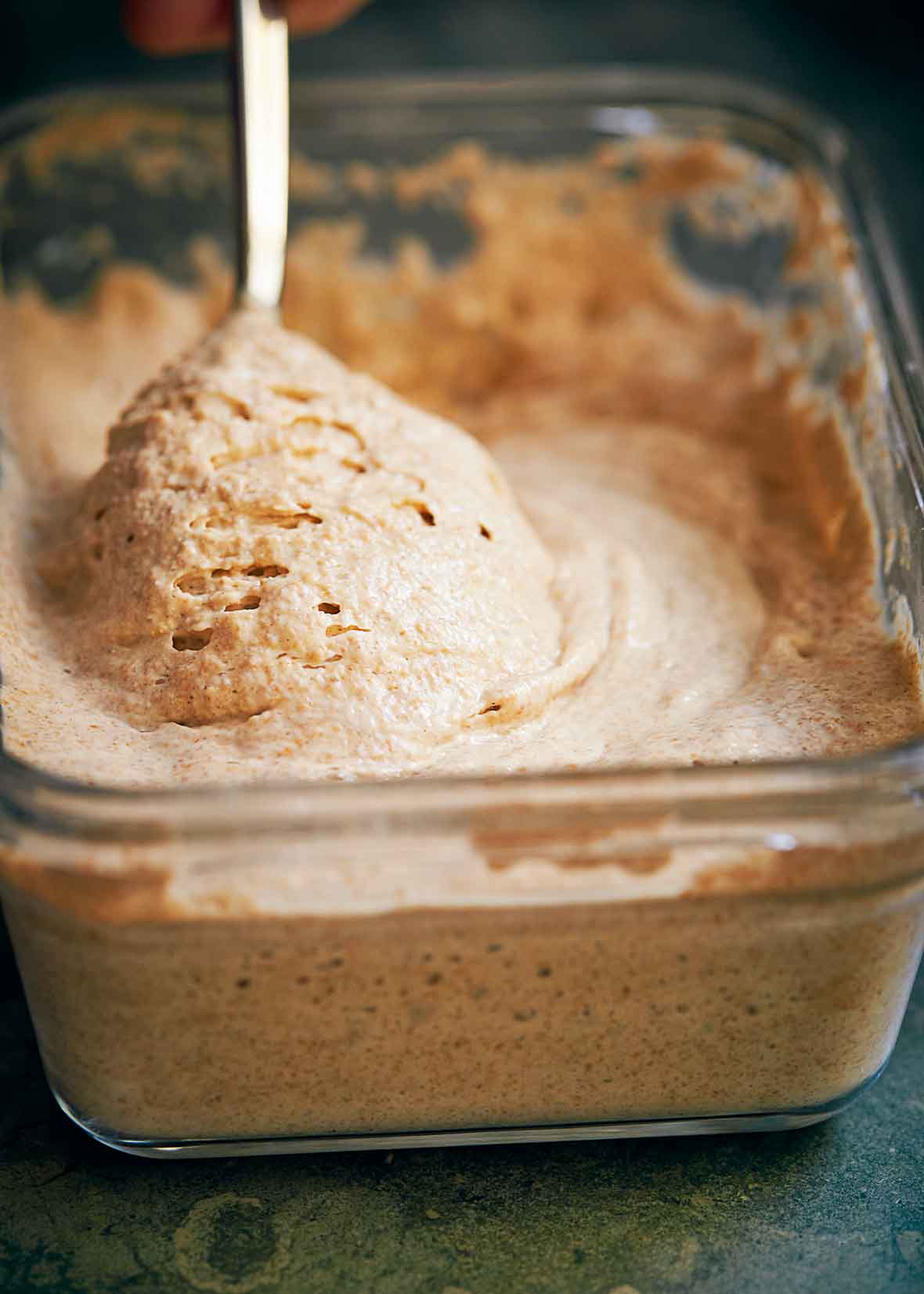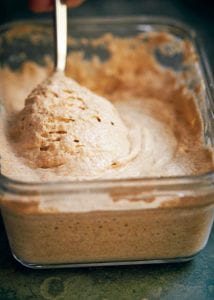
Jump To
A sourdough starter is the key to developing unique flavor in your bread. It takes several days of patience to wait for it to develop but takes minimal effort. And when properly cared for, your sourdough starter can last indefinitely, providing you with bread for years to come. A gift that literally keeps on giving.–Angie Zoobkoff
HOW DOES A SOURDOUGH STARTER WORK?
How exactly does a sourdough starter work? Read on for this explanation from author Nick Barnard…
“Flour, water, yeast, and salt. That’s all you need. Of these, the yeast is your catalyst of fermentation, as it devours the sugars in the grain and creates carbon dioxide, which leavens, or expands, the dough. Yeast is a fungus, and wild strains have been utilized for thousands of years by bakers throughout the world. Over the past two hundred years or so commercial yeasts have been cultivated for both the baking and brewing industries.
“Wild yeasts, unlike commercial strains, are made up of a happy union of fungi and bacteria (lactobacillus), where the fungi digests all the sugars, except the maltose, and produces carbon dioxide (the rise), and the lactobacillus digests the maltose and other sugars, and produces glucose, which the fungi can digest. The lactobacilli act anaerobically, meaning in the absence of oxygen, and, in digesting the sugars, they produce lactic acid, lowering the pH, and so create the sour taste in the dough. The very best sourdough has just the right combination of sweet yeastiness with a hint of sour. Some sourdoughs are famous: San Francisco sourdough is renowned for its tangy flavor. The species of lactobacillus first found there is named after the city, Lactobacillus sanfranciscensis, and is cultivated commercially and sold to bakeries worldwide to replicate this distinctive sourdough flavor profile.
“Rather than buying commercially produced fresh or dried cultivated yeast, you can create and nurture your own happy union of wild fungi and bacteria, using only flour and water. All the fungi and bacteria you need are floating in the air around you. Once it comes alive, your wild yeast is known as a starter or mother. You will also be creating your very own and unique wild yeast. Your sourdough starter is energized by the combination of microorganisms present in the air in your kitchen and home, which means that she’ll be helping you to make bread with your own individual and special flavors. (Naming your starter is highly acceptable.)”
☞ LEARN MORE, READ: HOW TO DRY SOURDOUGH STARTER

Sourdough Starter
Ingredients
- 1 2/3 cups whole wheat flour or whole spelt flour (165 g) or whole rye flour (172 g), depending on what sort of bread you want to make
- 1 1/4 cups freshly filtered water
Instructions
Day 1
- In a small to medium bowl, mix 1/3 cup flour and 1/4 cup freshly filtered water together thoroughly with clean fingers. Cover the bowl with a cloth or muslin and let it sit out at room temperature.
Day 2
- Stir in 1/3 cup flour and 1/4 cup water as you did on day 1. The developing sourdough starter should have the consistency of pourable oatmeal.
Day 3
- Add 1/3 cup flour and 1/4 cup water and stir to combine. By now or by day 4, you may well need to move your sourdough starter to a larger container, which will become its permanent home.
Day 4
- Stir in 1/3 cup flour and 1/4 cup water. By now you should see your sourdough starter coming alive and forming a light crust, under which will be a sponge of gently bubbling activity.
Day 5 and Beyond
- Add 1/3 cup flour and 1/4 cup water as in previous days, but from this day forward cover the container and keep your sourdough starter in the fridge unless you are refreshing (feeding) her. The wild yeasts will stabilize at between 35 to 40°F (2 to 4°C) and as they slow down their activity they will live quite happily for about 2 weeks, undisturbed, before they run out of nourishment.
Feeding the sourdough starter and creating a starter for baking
- To ensure that your sourdough starter thrives, you need to feed her at least once every 2 weeks, and in doing so you can remove a portion of the starter for your bread making. It’s ok if you notice some grayish water collecting on the starter when it’s chilled; just pour it off and carry on with your breadmaking. At any time within the 2-week period, remove the mother from the fridge, and refresh with the same weight of flour that you will be removing as a wild yeast (sourdough) starter. So if your bread making requires 1 1/4 cups (150 g) sourdough starter, feed the starter with 1 1/4 cups (150 g) flour and 2/3 cup (150 ml) water, stir to incorporate fully, and then leave it out at room temperature for 8 hours before returning it to the fridge. If you’re unable to feed your starter beyond 2 weeks, freeze her. She’ll be up for coming back to life once thawed and fed again.
Notes
How to make a sprouted sourdough starter
Yes, you can create and nurture your sourdough starter with sprouted flour and make the most wonderfully flavorful and easily digestible wild yeasted breads. When you refresh your sourdough starter, you will notice a more rapid and lively reaction as sprouted flour, being naturally sweeter, will ferment more quickly. You will also need a little more water than the daily 1/4 cup used in the recipe to achieve a pourable oatmeal consistency in the developing starter.
Nutrition
Nutrition information is automatically calculated, so should only be used as an approximation.










So I have seen three sour dough starters on this web site. I am using this one to make Pan Levain. I have a lot of starter left over- some of this and some from the refreshed starter. Do you have more recipes that THIS starter can be used for? OR How do you approach making, say one of you baguette or ciabatta recipes using this ?
Hi Andrea,
There are lots of good uses for sourdough discard – unfortunately we don’t have any recipes on our site just yet, but I would highly recommend using discard to make pancakes or crepes, or even thinning it out with water or milk and adding a little baking powder and seasoning to make a tempura batter. It’s also a great addition to banana bread! You could definitely try using the active starter in the ciabatta recipe in place of the biga, but we haven’t tested this so please be sure to let us know how that works for you!
Hope that helps!
Daniela
Do you refresh the starter with the new water and flour before or after removing your starter for a recipe? Thanks!
Toni, you would do it before removing the amount you need for a recipe.
Is there a specific reason to use whole wheat flour in your starter?
Hello, David. Yes, whole grains have more nutrients and sourdough-friendly microorganisms than all-purpose flour.
Great to know! Thanks! I’m on day 2 🙂
David, you bet!